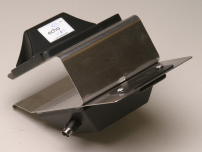In the wake of 9/11, government and industry have searched for ways to secure containers and cargo streaming across international boundaries. Although increasingly sophisticated tools exist, such as bomb sniffers and high-tech locks, developing a smart container—capable of sensing changes in the surrounding environment—ranks high on the list of ways to prevent crime and terrorism.
Savi Technology, a Sunnyvale, Calif., provider of supply chain asset management and security solutions, is among the companies working on a smart-container solution. It has introduced Savi Sentinel, a battery-powered RFID device that clamps to a standard intermodal shipping container.
The Sentinel acts as a sensor that can detect if the container has been opened and monitors other sensors that report on the conditions and integrity of goods in the container. It also provides two-way wireless communications within a supply chain network to enable real-time auditing.
“The Sentinel serves as the central brains of a container,” says Blair LaCorte, Savi’s executive vice president of business development and marketing. Adds Ravi Rajapakse, Savi’s chief technology officer: “The design and technology are tailored to address both the security concerns and ongoing inefficiencies inherent in the transport of intermodal containers.” Savi demonstrated the product, along with an integrated electronic bolt seal by E. J. Brooks and a radioactivity sensor by RAE Systems, at the U.S. Maritime Security Conference held in New York City in late October.
Once clamped to the edge of a container’s door, the Sentinel’s two-way transponder communicates with the RFID tags wired to other sensors that measure, among other things, changes in light and atmospheric pressure; the presence of environmental toxins; and shock, vibration and radioactivity. The unit also works with Savi’s automated global tracking network, which uses GPS technology and RFID readers located at shipping terminals to furnish shippers, carriers and logistics service providers with real-time visibility about the location, status, security and integrity of their shipments.
Because Savi has designed the Sentinel as an open system that can use both active and passive tags, it’s possible to customize the RFID network for a shipper’s specific needs—whether it’s detecting food spoilage or the presence of terrorist weapons. The Sentinel works with tags that operate at 433 MHz or 123 KHz, providing both long (up to 300 feet) and short (six to eight feet) read ranges, respectively.
Although the reusable device adds about $15 to $50 to the cost of a container, LaCorte believes that it offers several hundred dollars worth of benefits. In addition, the U.S. Customs Service is now advocating the use of smart containers for sea and air shipping and will likely offer expedited passage and reduced paperwork to shippers that use such systems. The Sentinel represents the second generation of smart-container devices. Savi’s first generation security sensor seals–which can detect when a container’s seal is broken—are used on more than 1,000 containers in 15 ports worldwide.


